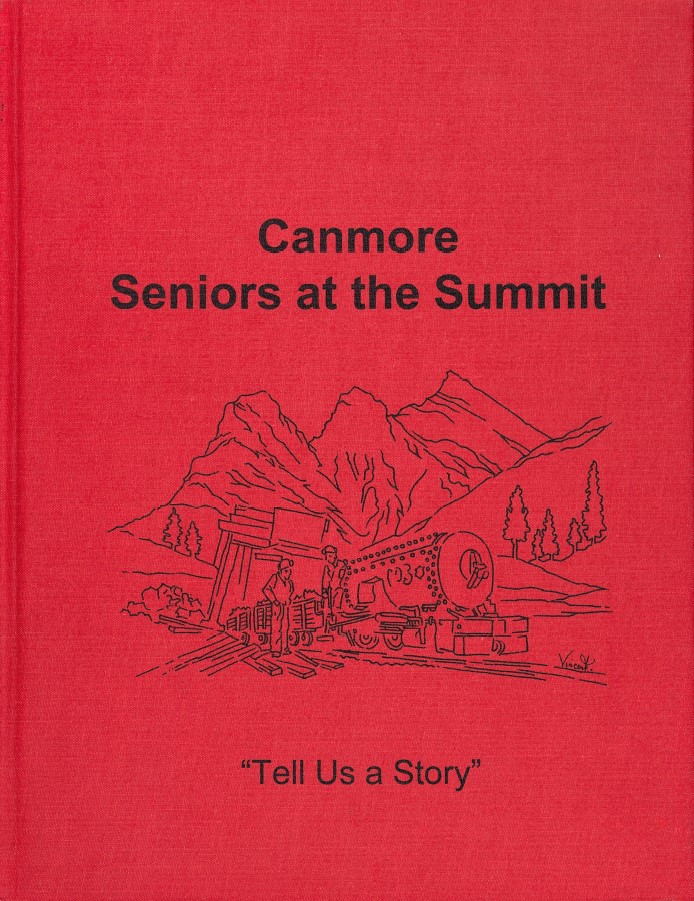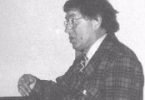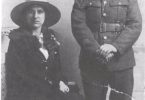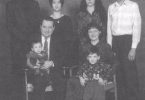I was born in 1914, in Canmore, at home, with Dr. Worthington in attendance. It cost ten dollars. My daughter was delivered by the same doctor. My daughters are Leona Fowers in Calgary and Marilyn Cohen in Edmonton. I have five grandchildren.
I started school when I was five. School was where Mironuck’s Drug Store is today. I had a wonderful new wooden pencil box to start school and it got stolen. The school had a big heater and big tables and benches. I went to the other school to grade eight. That school is now torn down. Miss Friesen was the teacher.
For entertainment, we played hopscotch. We searched for a nice piece of glass for this game. Alleys and marbles were played outside against the wall of the school. The boys, my brothers, played hockey. Alex has passed away. He played for New York and Chicago.My next brother, John, was nicknamed Buck for his “cowboy” side. He went on trail rides or on horseback to go fishing. Next brother was Arthur. Another brother, Bill, drowned at Spray Lakes. My sister, Annie Hubman, was a speed skater. We were able to come home from school for lunch.
Mom had cows and chickens right here in Canmore so we had our own milk. Kernicks delivered milk in town. Our water, hard, was pumped from the well, at first by hand, and later we had an electric pump. Dad always fixed pumps for people. They would freeze in winter. Light was provided by coal oil lamps, a source of worry to Mom when she was out milking the cows. For groceries, a man came and took the order, then delivered the groceries with a team of horses. Mom baked her own bread and made an assortment of treats from the dough. Mom was always at home, if not in the house, then in the garden.
Since I (Broni) was the oldest, I helped with the chores. On Saturdays, I cleaned the cupboards and washed the kitchen floor. At sixteen, I started babysitting. My first job earned me thirty dollars which was used to help buy hay. I married a local boy, born here in Canmore, Joe Shandruk. He started working in the mine at eighteen and was president of the Union.
My dad came here about 1900. He worked on the railroad, then in the mine for about two dollars a day.
During the Depression we saw hobos from the train. People gave the hobos meals. People were given bags of flour if they were in need.
Canmore was a beautiful town. For fun there was hiking, birthday parties, dances, shows. A show cost ten cents. We couldn’t all go to the show each week as we had to wait until it was our turn. With several brothers and sisters, our turn didn’t come around too often. Mr. Ramsey had the show hall. My brothers skated on the river, in the rink, and on little rinks made in the backyard. The iceman cut blocks of ice from the Bow River all winter long.
The yard had an outhouse. Catalog paper was used to paper the inside of the toilet and cut into pieces for tissue. At Christmas, soft paper from the oranges was appreciated. Saturday night was bath night. Lye was used for good cleaning. A dipper in the pail was used for drinking water. Babies were fed cow’s milk.
Christmas was special for the Christmas oranges. Twelve meatless dishes were served in some homes on Christmas Eve. Many celebrated regular Christmas, some Ukrainian Christmas. Candles were used as tree decorations as were oranges and coloured walnuts. Mom used to hang nice colored papers with a candy in each paper. By morning, just the papers were hanging as the candies had mysteriously disappeared in the night so Mom would refill the papers. Santa came. We got a toy each and probably a box of chocolates under the tree for the whole family. We got all dressed up for the Christmas concert. Some girls had rag ringlets. The school put on the concert and the miners gave out gifts.
Sweet bread was baked at Easter and eggs were coloured with onion peel.
July 1 was the big day for the miners’ picnic. The miners put on the picnic and supplied everything. There were ball games, races, a march, tug-of- war, free candies, ice cream. The band played in the band hall situated in the middle of the park but the band hall is now torn down.
Mom wore house dresses covered by a cape when needed. She usually wore her hair in a bun. One time she got her hair cut and curled, then didn’t like to go out to be seen with this new hairdo.
She used to pick raspberries and blueberries in what is now Three Sisters.
Dad, William Kaleta, was the janitor at the school. He shovelled lots of coal at night to have the school ready for next day. Coal was the main fuel, then it was replaced by gas. Mr. Towers delivered the coal to the log coal shack in the backyard. It was beside the outhouse. The cesspool was in the backyard too.
Mom did not know my dad until she came here to marry him. Dad came here from Edmonton. He ate at Mrs. Klemchuk’s. He sent money for “the girl in the picture” to come here from Poland.
When war was declared, Buck joined up. He was there from day one until it ended. We sent parcels containing cakes and homemade socks. What a happy day it was when Buck came home!
Fires and floods were a part of Canmore history. The health care was good. A doctor would make house calls. For eyes and teeth, we went to Banff or Calgary. There was a little hair shop near the Union Hall where Evelyn did our hair. Now fourplexes are replacing houses. When we go uptown so many people are strangers, so different from old Canmore where everyone knew everyone.
In Canmore Seniors at the Summit, ed. Canmore Seniors Association, 2000, p. 259-260.








